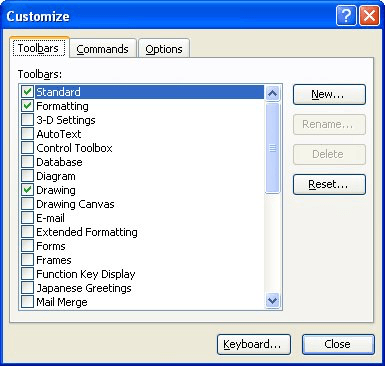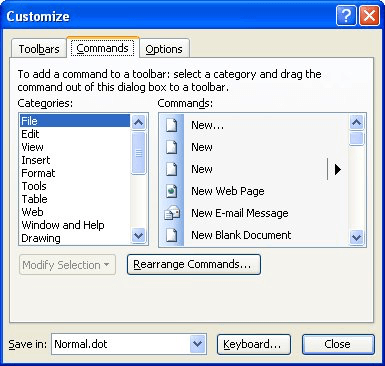Written by Allen Wyatt (last updated February 6, 2021)
This tip applies to Word 97, 2000, 2002, and 2003
Word allows you quite a bit of latitude in how you can customize the program to reflect how you want to do your work. One of the elements of the program you can change is the toolbars. You can add, remove, or edit buttons that appear on any toolbar.
To customize a toolbar, follow these steps:

Figure 1. The Toolbars tab of the Customize dialog box.

Figure 2. The Commands tab of the Customize dialog box.
WordTips is your source for cost-effective Microsoft Word training. (Microsoft Word is the most popular word processing software in the world.) This tip (1675) applies to Microsoft Word 97, 2000, 2002, and 2003.

Discover the Power of Microsoft Office This beginner-friendly guide reveals the expert tips and strategies you need to skyrocket your productivity and use Office 365 like a pro. Mastering software like Word, Excel, and PowerPoint is essential to be more efficient and advance your career. Simple lessons guide you through every step, providing the knowledge you need to get started. Check out Microsoft Office 365 For Beginners today!
If you don't like where your toolbars are located, just move them around.
Discover MoreIf you make changes to a toolbar in Word, you expect those changes to be available the next time you start the program. ...
Discover MoreNeed to remove a toolbar button, but don't want to go through the hassle of displaying the Configure dialog box? You can ...
Discover MoreFREE SERVICE: Get tips like this every week in WordTips, a free productivity newsletter. Enter your address and click "Subscribe."
There are currently no comments for this tip. (Be the first to leave your comment—just use the simple form above!)
Got a version of Word that uses the menu interface (Word 97, Word 2000, Word 2002, or Word 2003)? This site is for you! If you use a later version of Word, visit our WordTips site focusing on the ribbon interface.
Visit the WordTips channel on YouTube
FREE SERVICE: Get tips like this every week in WordTips, a free productivity newsletter. Enter your address and click "Subscribe."
Copyright © 2025 Sharon Parq Associates, Inc.
Comments